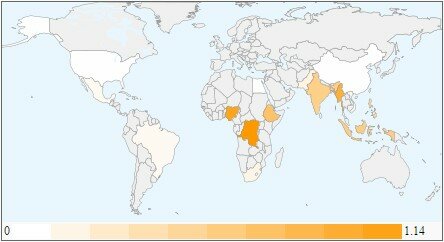A new “worm index” developed by Sabin President Dr. Peter Hotez and Baylor College of Medicine’s Dr. Jennifer Herricks reveals a strong association between neglected tropical diseases (NTDs) and human development.
The index was based on the disease burden of major worm (or helminth) infections: intestinal helminths, lymphatic filariasis and schistosomiasis, which can lead to diarrhea, anemia, disability, disfigurement and even death. Increasing evidence over the last decade links the most common NTDs to significant adverse impacts on both human and economic development.
Hotez and Herricks created the worm index (see map below) using World Health Organization (WHO) data on disease burden for these worm infections in the world’s 25 most populous countries. Countries’ worm indices range from 0-1, with higher indices indicating a higher disease burden.
Heat map for worm index of the 25 most populous countries:

Hotez and Herricks then compared their worm index to the United Nations Development Programme (UNDP) human development index (HDI), which measures a country’s achievement in education, standard of living and years of life lived in good health.
This side-by-side comparison uncovered a strong negative correlation (see graph below).
Comparison of HDI to worm index in the 25 most populous countries:

It is tempting to conclude from these results that worm infections hold back human development, but it could just as easily be that situations of poverty (poor healthcare infrastructure and lack of access to clean water and sanitation, for example) result in worm infections. “It is possible or even likely that the causes and effects flow in both directions,” the researchers state.
That said, evidence illustrating this relationship abounds. Hotez and Herricks cite studies from Kenya showing that deworming led to improvements in school attendance and participation, and the effects of deworming could still be seen into adulthood—adults who received deworming treatments as children were more productive, both in hours worked and wages earned. Higher wages and more schooling are critical tools for achieving the Sustainable Development Goals (SDGs).
“Given the strong associations between helminthic and other NTDs and mental, physical, and economic human development, vulnerable and excluded populations, and HDI, in the coming months and years it may become essential to give due consideration to eliminating helminth infections as a means to achieve SDGs. Of course, poverty, “Water, Sanitation and Hygiene” (WASH), and nutrition play an important role in health outcomes. As we look to reduce poverty and increase WASH and nutrition, we must also focus on chronic diseases such as helminth infections that reinforce the cycle of poverty and malnutrition. Therefore, we suggest that the NTDs need to be an important consideration in any discussion about the SDGs, and helminth control and elimination as proposed by the 2012 London Declaration for NTDs must be embraced by the SDGs and the sustainable development community.”
No matter which came first—poverty or worms—the fact is that these infections impact millions of people every day, disabling communities’ workforces and further limiting economic growth where it’s needed most.
